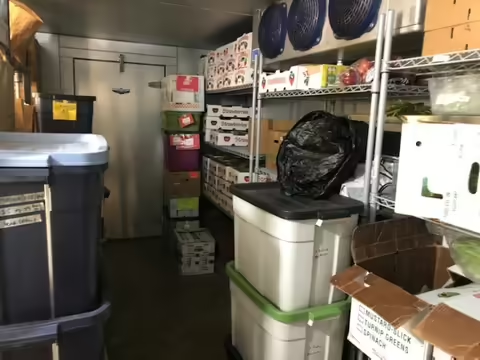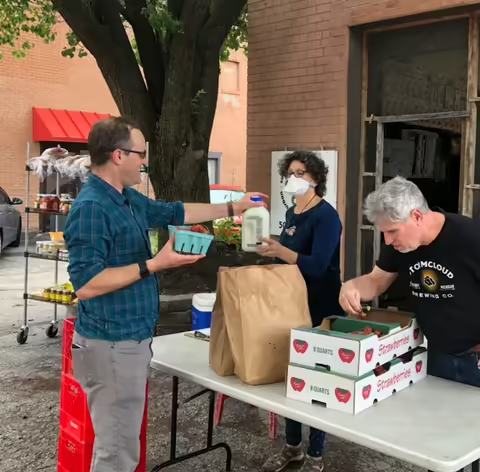In 2007, sisters Jamie Choler and Sara Choler Hale were picking up their weekly box of vegetables from Biver Farms. They were part of a Community Supported Agriculture (CSA) program in which the customer agrees to pay the farmer upfront and picks up weekly “shares” of what the farmer has to harvest throughout the growing season.
CSAs are meant to help small-scale farmers. This model was first introduced by Black horticulturalist Booker T. Whatley in the 1960s and over the past 30 years become more popular by the local food movement. With CSAs, farmers can better predict how much to plant and have the money to purchase the necessary inputs at the beginning of the season. Over the course of the growing season farmers and the consumers share in the risk of farming stemming from uncontrollable factors such as floods, droughts, or unusual cold spells.
However, when picking up their CSA boxes, the sisters became aware of the stress their farmer endured in trying to provide a diverse array of produce each week. That is how they came up with the idea of a Combined CSA (CCSA).
"We wanted to offer a full array of local foods…but not just a co-op where members just pick what they want. We wanted to help our local produce farmers have a consistent market without having to spend half their week at farmers’ markets.”
- Sara Choler Hale
Beginning struggles
Sara and Jamie started reaching out to other local farmers, and eventually other food producers including bakers, canners, and chefs. They also made relationships with their founding members who funded the start-up costs.
In 2008 they signed the lease on their building and four days later, made their first delivery as Fair Shares CCSA. They were not quite ready for the business this would become. Sara and Jamie had other jobs when they started Fair Shares, thinking this would just be a part-time gig. They soon realized that this operation was going to be more than a full-time job.
“At the beginning, we were working 80 hours a week,” Sara remembers. They knew local farmers and producers and how CSAs worked, “but nothing about proper produce storage and handling, or about how to calculate and plan for extra inventory.”
They also started with a single-door freezer in their dad’s garage, not quite enough cold storage. They now have seven chest freezers, several reach-ins, a large walk-in cooler, and several portable coolers with ice packs, as well more paper products, veggie bags, masking tape, and Sharpies than they could have imagined. That is what they need to sell over 800 items yearly, generally about 500 different items per week. These items come from 33 farmers and entrepreneurs in the bi-state region surrounding St. Louis.
CCSAs benefit farmers and customers
After all this work, has Fair Shares reached its goal in providing a variety of produce to consumers with less work from the farmers? This may be evident in changes the network’s farmers have made.
“Over the years, a few of them stopped selling at the farmers’ markets because it’s easier to sell everything to us, but most sell at one or two farmers’ markets near their farm,” Sarah says.
This model is also more convenient to some customers. Instead of spending time visiting with multiple vendors at busy farmer’s markets, they just order online and pick up their food from Fair Shares. The base of each share is more typical of a traditional CSA – produce items farmers have an abundance of that customers must take. However, there are also items that can be swapped out for ones that customers choose, such as meat, dairy, canned goods, frozen prepared foods, baked goods, and additional or specialty produce, such as microgreens and pawpaws.
During the peak of the pandemic, their membership doubled. Sara explains, “when people were afraid to go to the store, they came and got their food from Fair Shares.” Not everyone has stayed “but we have a lot of people who have learned the benefits of eating happy, local food and love being part of Fair Shares.”
Fair Shares uses the term “happy” with their food because it is sourced from farmers using environmentally-friendly and animal welfare practices. Most produce they source is organically grown and the eggs, dairy, and meat come from pastured or free-range animals.
However, this “happy” food is more expensive to grow, and therefore to purchase. Sara acknowledges that “one of the major challenges is getting the community to commit to supporting local farmers and paying the price that food actually costs.” They offer three different share options – full share, half share, and mini share – at different price points. They were set up to accept Supplemental Nutrition Assistance Program (SNAP) benefits but never found the customers to use it, so they are not currently set up to do so now.
Can CCSAs work elsewhere?
Overall, Fair Shares CCSA is certainly more complicated than a traditional CSA. But Sara says their loyal members absolutely love it. Sara thinks the CCSA model would work in other places.
“Relationships with farmers and with members are critical. When we started, a number of farmers were pretty dubious when we asked them to grow large amounts of food for us," Sara says. "The farmers we knew personally stepped up, and once we had established that our system would work, we had farmers’ contacting us wanting to get in on our producer list.”
- Learn more about why purchasing local foods this summer may be a good deal.
- Find local food near you.
Meet the Author
Grace Margherio is the Local Food Systems and Small Farms Educator in East St. Louis, Ill. She works with the Jackie Joyner-Kersee Food, Agriculture, and Nutrition partnership, leading agricultural education with the youth at the Jackie Joyner-Kersee Center and working with Greater East St. Louis area community to support urban agriculture and food access.


